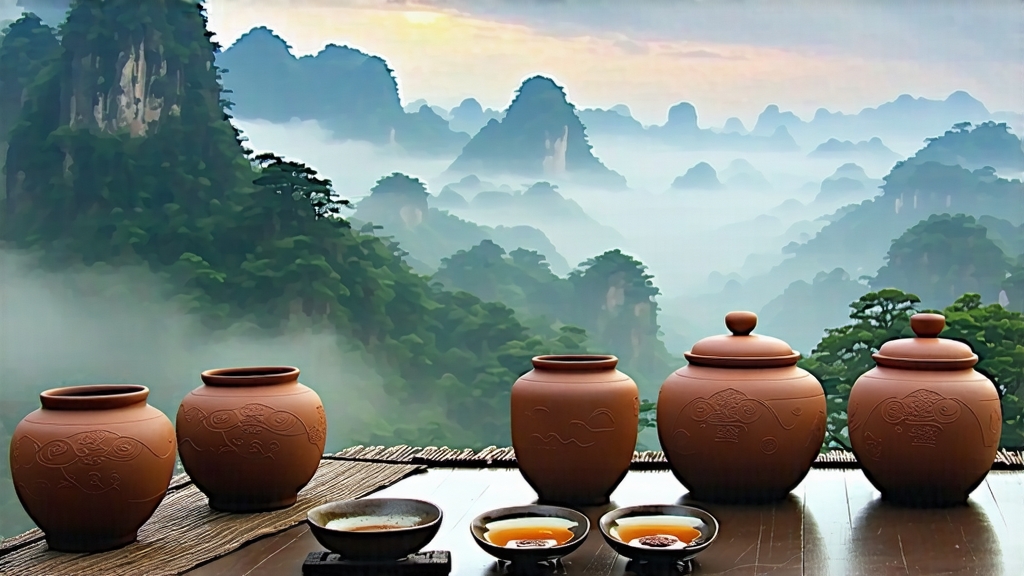
Tucked away in the humid, karst-pocked southwest of China, the small town of Liubao in Guangxi Zhuang Autonomous Region guards a tea secret that once traveled the Ancient Tea-Horse Road, paid imperial tributes, and still fuels the dawn porridge stalls of Guangzhou dockworkers. Liu Bao—literally “Six Forts,” named after the six strategic outposts that once protected the tea mule caravans—is the darkest, earthiest member of the Chinese black (post-fermented) tea family. While Pu-erh has conquered auction catalogs and investment portfolios, Liu Bao remains the quiet, affordable cousin whose flavor smells of rain-soaked pine bark and whose story is stitched into the bamboo-leaf parcels that carried it to Southeast Asia for over three centuries.
History: From Tribute Caravan to Kopitiam Cup
The earliest written record appears in the 1567 edition of the Cangwu County Gazetteer, noting that “dark tea from Liupu” was bartered for salt and horses with Tibetan merchants. By the Qing Qianlong era (1736–1795), Liu Bao’s fame peaked: each spring, 3,000 bamboo baskets lined with banana leaves were lashed onto mules, escorted by armed guards past the Pearl River delta, and reloaded onto junks bound for Singapore, Kuala Lumpur and Jakarta. The British Straits Settlements customs logs of 1888 list “Liew Poo” as the third-largest Chinese tea import after Keemun and Oolong, valued for its ability to calm humid stomachs and pair with kaya toast. When the imperial tribute system collapsed in 1908, Liu Bao slipped into obscurity, surviving only as a cheap “coolie tea” pressed into 30 kg baskets and retailed from gunny sacks in Penang’s Chowrasta Market. The 2007 Pu-erh bubble revived curiosity; suddenly, vintage 1972 Liu Bao bricks appeared in Hong Kong teashops, their betel-nut and camphor bouquet compared to well-aged sheng Pu-erh at one-tenth the price.
Terroir: Where Mist, Red Soil and Cinnamon Trees Meet
The micro-region lies at 23° N, 200–500 m above sea level, where the subtropical monsoon drapes 1,800 mm of rain over purple-red lateritic soil rich in iron and potassium. Indigenous cinnamon trees (Cinnamomum burmannii) intercrop with the tea gardens; their fallen leaves decompose into a spicy humus that locals swear sweetens the leaf. The cultivar is a medium-leaf Camellia sinensis var. sinensis locally called “Yuntai Da Ye” (cloud-platform big leaf), prized for its thick cuticle and high ratio of pectin to cellulose—ideal for the heavy wet-pile fermentation that follows.
Craft: The Bamboo Basket Alchemy
Liu Bao’s processing is a six-act play that begins like green tea and ends like compost poetry.
- Pluck: one bud and three to four leaves in the dew-cooled dawn of Qingming week.
- Kill-green: 280 °C drum roasting for 3–4 min to arrest oxidation while preserving enzymes for later microbial action.
- Rolling: 40 min of light pressure to fracture cell walls without expelling too much juice.
- Sun-drying: spread on bamboo mats for six hours until leaf moisture drops to 12 %; the sun fixes a golden-red rim along the serrated leaf edge, the so-called “tiger skin” sign prized by buyers.
- Pile-fermentation: the signature step. Leaves are sprayed with mountain spring water (pH 6.2), heaped 70 cm deep inside bamboo steamers lined with gunny sacks, and left in a humid 28 °C room for 45–60 days. Every five days the pile is turned, allowing Aspergillus niger, Blastobotrys adeninivorans and local yeasts to bloom. The temperature is kept below 55 °C to prevent over-caramelization; masters gauge readiness by aroma—when the sharp compost note softens into dried jujube and wet moss, the pile is broken.
- Steam-press and basket aging: the fermented leaf is steamed for 30 s, packed into 30 kg cylindrical bamboo baskets lined with banana leaf, and transferred to an underground cave or a warehouse with 85 % humidity and constant 25 °C. Here it sleeps for a minimum of three